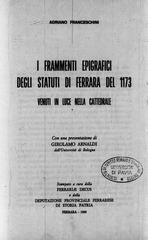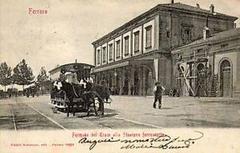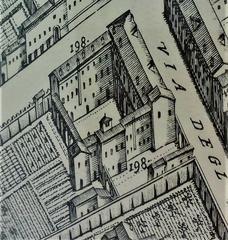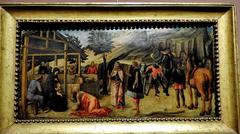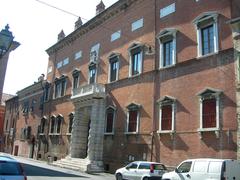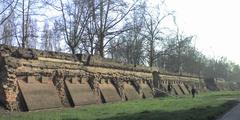Palazzo Schifanoia Visiting Hours, Tickets, and Historical Sites in Ferrara
Date: 14/06/2025
Introduction to Palazzo Schifanoia and Its Historical Significance
Nestled within the historic city walls of Ferrara, Italy, Palazzo Schifanoia stands as a magnificent testament to Renaissance art, culture, and the refined leisure of the Este court. Commissioned in 1385 by Alberto V d’Este as a suburban retreat to “escape boredom” (schifar la noia), the palace evolved into the Este family’s premier pleasure residence, reflecting their political influence and artistic patronage. Its most celebrated space, the Salone dei Mesi (Hall of the Months), boasts one of the most intricate 15th-century fresco cycles, blending classical mythology, astrology, and Este court life into an immersive narrative that immortalizes Borso d’Este’s rule and Renaissance humanist ideals. After centuries of decline, industrial use, and neglect, the palace has been meticulously restored and today serves as a museum providing an unparalleled journey through Ferrara’s cultural heritage (Wikipedia; Ferrara Terra e Acqua; Apollo Magazine).
This guide provides essential information about visiting Palazzo Schifanoia: hours, tickets, accessibility, guided tours, and nearby attractions. It also explores the palace’s architectural evolution, its artistic treasures—particularly the frescoes by Francesco del Cossa and the Ferrara School—and its enduring role in Ferrara’s UNESCO World Heritage status.
Table of Contents
- Discover Palazzo Schifanoia: A Renaissance Treasure in Ferrara
- Origins and Early Development
- Renaissance Expansion and Artistic Flourishing
- Decline and Rediscovery
- Visiting Palazzo Schifanoia: Practical Information
- Historical Significance in Ferrara and Beyond
- The Este Court and Artistic Identity
- The Salone dei Mesi: Masterpiece of Allegory
- Artistic Legacy and Influence
- Restoration and Accessibility
- Must-See Highlights
- Visitor Information: Hours, Tickets, and Tips
- Getting There and Nearby Attractions
- FAQs
- Summary and Visitor Tips
- References and Useful Links
Discover Palazzo Schifanoia: A Renaissance Treasure in Ferrara
Palazzo Schifanoia is one of Ferrara’s most captivating historical sites, offering an unparalleled window into the splendor of Renaissance art and aristocratic life. Whether you are an art lover, history enthusiast, or traveler seeking an authentic experience, this former Este pleasure palace promises a remarkable journey through time.
Origins and Early Development
The roots of Palazzo Schifanoia trace back to 1385, when Alberto V d’Este commissioned a retreat meant “to escape boredom”—a concept captured in the palace’s name (Wikipedia; Ferrara Terra e Acqua). The original building was a single-storey, L-shaped structure with battlements and a loggia facing a garden, perfect for hosting banquets and courtly entertainments (Progetto Storia dell’Arte). Its location at the edge of Ferrara’s urban core, in the area once used for cattle markets (Pratum Bestiarium), allowed the Este elite to enjoy suburban tranquility without leaving the city (Progetto Storia dell’Arte).
Renaissance Expansion and Artistic Flourishing
A dramatic transformation came under Borso d’Este (1450–1471), who expanded the palace and elevated it to reflect Ferrara’s rising status. In 1465, architect Pietro Benvenuto degli Ordini added a noble floor for ducal apartments, giving the building much of its current appearance (Italian Tours; Progetto Storia dell’Arte).
The crowning artistic achievement was the Salone dei Mesi frescoes (1469–1470), conceived by Este court astrologer Pellegrino Prisciani and executed by the Officina Ferrarese artists: Francesco del Cossa, Cosmè Tura, Ercole de’ Roberti, and the “Master with Wide Eyes” (Wikipedia). This grand cycle originally depicted all twelve months, arranged in three vertical registers: Olympian deities above, zodiac and allegories in the middle, and scenes of Este court life below. This ambitious iconography reflected Renaissance humanism’s integration of classical, astrological, and contemporary courtly themes (Progetto Storia dell’Arte).
 Caption: The Salone dei Mesi fresco cycle—an unrivaled masterpiece of Renaissance allegory.
Caption: The Salone dei Mesi fresco cycle—an unrivaled masterpiece of Renaissance allegory.
Decline and Rediscovery
The palace’s fortunes waned after the Este family’s expulsion in 1598 and Ferrara’s annexation by the Papal States. The building suffered neglect, alterations, and industrial repurposing, with its frescoes whitewashed and forgotten (Italian Tours). Rediscovered in 1821, the frescoes became the focus of restoration, leading to the foundation of the Museo Civico di Palazzo Schifanoia in 1898 (Inferrara).
Visiting Palazzo Schifanoia: Practical Information
Opening Hours
- Tuesday to Sunday: 9:00 AM – 7:30 PM (last admission 6:30 PM)
- Closed: Mondays, January 1, December 25
- Always check the official website for updates.
Ticket Prices
- Full price: €12 (2025)
- Reduced: €9 (over 65s, teachers, groups 15+)
- Free: Under 18s, disabled visitors and companions, school groups, MyFe Card holders, tour guides, journalists, visitors on their birthday
- Tickets include access to the Lapidary Museum (Musei Ferrara; Nomads Travel Guide).
Guided Tours
- Group tours: ~€130 (up to 25), plus €2 per person for radio guides (groups of 7+)
- Individual tours: ~€22, with reductions for under-18s and disabled visitors (Arte e Musei; Elisabetta Gulino)
- Reservations: Recommended for groups and peak periods
Accessibility
- Fully wheelchair accessible (ramps, elevators)
- Audio guides and tactile materials available
- Free admission and priority entry for visitors with disabilities (Ferrara Terra e Acqua)
Historical Significance in Ferrara and Beyond
Palazzo Schifanoia is the only Este “delizia” preserved within Ferrara’s city walls and is central to the city’s UNESCO World Heritage designation (Ferrara Delta Po Patrimonio Mondiale). The palace’s frescoes represent a rare survival of 15th-century court art, providing insight into the intellectual, political, and artistic currents of Renaissance Ferrara (Wikipedia; Italian Tours).
The Este Court and Artistic Identity
Palazzo Schifanoia’s identity is inseparable from its origins as a Renaissance “delizia”—a pleasure palace blending leisure, intellectual pursuits, and festivity (Apollo Magazine). Under Borso d’Este, the palace became a symbol of power and sophisticated taste, culminating in the Salone dei Mesi cycle commissioned to celebrate his rule (Ferrara Terra e Acqua).
The Salone dei Mesi: Masterpiece of Allegory
The Salone dei Mesi is the artistic heart of the palace and among the most important surviving Renaissance fresco cycles. Only the panels from March to September remain. Created by Francesco del Cossa, Ercole de’ Roberti, and Cosmè Tura, each month is depicted in three registers:
- Upper: Olympian gods and goddesses (divine influence)
- Middle: Zodiac and allegories (astrological order)
- Lower: Este court scenes (rule and prosperity)
This complex iconography fuses classical myth, astrology, and Este propaganda, creating a visual manifesto of Renaissance humanism (Frieze; Apollo Magazine).
Artistic Legacy and Influence
Francesco del Cossa’s frescoes, particularly for March–May, are celebrated for their color and dynamism. These, along with the works of Ercole de’ Roberti and Cosmè Tura, defined the Ferrara School’s influence on Renaissance art (Frieze). Beyond the frescoes, the museum houses works by Garofalo, Donatello, and others, cementing its importance as a cultural repository (Ferrara Terra e Acqua).
Restoration and Accessibility
Following the 2012 earthquake, Palazzo Schifanoia underwent major restoration, including structural reinforcement and modern accessibility improvements (Apollo Magazine; ARQA). The museum now spans 21 rooms, displays over 250 works, and features barrier-free access, digital tools, and multimedia guides (ARQA; The Travel Folk).
Must-See Highlights
Salone dei Mesi (Hall of the Months)
The centerpiece fresco cycle, depicting the months, zodiac, and Este court scenes. Surviving panels from March to September, painted by del Cossa, de’ Roberti, and Tura, are masterworks of Renaissance allegory (Wikipedia; Ferrara4All; Lonely Planet).
Sala degli Stucchi (Hall of Virtues)
Features a coffered ceiling and a richly decorated frieze with representations of virtues and Este emblems (Wikipedia).
Marble Portal and Facade
The 1470 marble portal, designed by Pietro Benvenuto degli Ordini, displays the Este coat of arms and unicorn, symbolizing family prestige (Wikipedia).
Museum Collections
The Civic Museum of Ancient Art includes Renaissance ceramics, numismatics, ivories, illuminated manuscripts, and ancient pottery (Ferrara4All).
Gardens and Architecture
While much of the original Renaissance gardens have been lost, the palace’s layout and green space recall the villa suburbana tradition (Wikipedia).
Visitor Information: Hours, Tickets, and Tips
- Hours: Tuesday–Sunday, 10:00–19:00 (last entry 18:00); closed Mondays
- Tickets: €12 full, €9 reduced, free for under-18s and other categories
- Guided Tours: Book in advance for best availability (Musei Ferrara)
Practical Tips:
- Book in advance, especially on weekends and holidays
- Arrive early for quieter viewing of the frescoes
- Use the MyFe Card for discounts and city tax exemption
- Dress comfortably for walking and standing
- Check the official website for events and temporary exhibitions
Getting There and Nearby Attractions
Address: Via Scandiana, 23, 44121 Ferrara, Italy (Guide to Europe)
By Foot: 20 minutes from Castello Estense
By Bus: No. 1 or 9 to “San Rocco Medaglie d’Oro”; No. 6 to “Alfonso d’Este Medaglie d’Oro”
By Car: Parking at San Rocco’s Ramparts (paid) or Corso della Giovecca
Nearby:
- Castello Estense (1.1 km)
- Museo Archeologico Nazionale (0.4 km)
- Casa Romei (0.4 km)
- Ferrara’s City Walls (Lonely Planet; Rick Steves Forum)
FAQs
Q: Are tickets available online?
A: Yes, via the museum website and partner platforms.
Q: Is it suitable for children?
A: Yes, with free admission for under-18s.
Q: Are guided tours and audio guides available?
A: Yes, in multiple languages.
Q: Is the museum accessible?
A: Fully wheelchair accessible and welcoming to all visitors.
Q: Can I take photos?
A: Photography without flash is allowed; check for current policies on site.
Summary and Visitor Tips
Palazzo Schifanoia embodies the essence of Renaissance artistry and Este court culture. The Salone dei Mesi frescoes, with their blend of astrology, myth, and historical narrative, are an unparalleled achievement. Recent restorations and enhanced accessibility ensure all visitors can enjoy its treasures. Its central location makes it easy to combine your visit with Ferrara’s other historical landmarks, creating a rich and rewarding exploration of the city’s Renaissance heritage.
For the best experience:
- Plan ahead and check the official website for current hours and tickets
- Consider a guided tour for deeper insight
- Download the Audiala app for an audio guide
- Explore nearby attractions and enjoy local cuisine
References and Useful Links
- Palazzo Schifanoia - Progetto Storia dell’Arte
- Palazzo Schifanoia - Italian Tours
- Palazzo Schifanoia - Ferrara4All
- Palazzo Schifanoia - Musei Ferrara
- Apollo Magazine: Reopened Palazzo Schifanoia Ferrara
- Ferrara Terra e Acqua: The Wonders of Este Art
- ARQA: The Schifanoia Museum in Ferrara
- Frieze: Picture Piece: The frescoes of Palazzo Schifanoia, Ferrara
- Nomads Travel Guide: Palazzo Schifanoia
- Lonely Planet: Palazzo Schifanoia
- Wikipedia: Palazzo Schifanoia
- Arte e Musei: Guided Tours at Palazzo Schifanoia
- Elisabetta Gulino: Palazzo Schifanoia Itinerary
